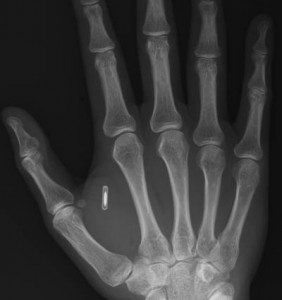In recent years, we have seen the emergence of microchip technology. With chip cards becoming the standard in almost all transactions, could we possibly see a banking implant in the next few years?
This sounds like something out of a terrible dystopian novel series, we know, but it does seem likely. We have been able to use microchips in debit and credit cards since the 1980s, but it was not until 2014 did they become the standard. Under the guise of being harder to crack, chip cards and readers have taken over the world.

Moving toward a wearable that holds our banking information would be a logical step. These subdermal implants are already in use. A company in Sweden has started allowing employees to voluntarily have a RFID chip implanted in their hands. The chips are used to open doors around campus. But with the right configuration, in theory, they could be used for transactions.
A banking implant has been used already.
Senior writer for Buzzfeed, Charlie Warzel, has already made history as the first person to use a banking implant. In the piece, Warzel wanted to see if he could use his phone for all his transactions for an entire month. During his experiment, he had an implant inserted into his hand and then linked to his virtual wallet. After a few moments, he accomplished his mission paying for his meal.

With this single transaction, we have started taking steps toward developing banking implants for the future. The implant itself is about the size of a grain of rice and can be placed in less than a minute with or without a local anesthetic. The most you will feel is a slight pinch when it is injected. After you will be free to program your chip to for whatever you may need.
Drawbacks to having a banking implant.
We have no clue what this will eventually do to our bodies. Having a banking implant inserted makes you feel like a spy, but spies are invincible. The human body has a healthy habit of rejecting foreign objects from itself. Most of the time this is from erosion of the material. There have already been cases with replacement joints degrading over time in patients.
Aside from erosion, this opens up a new world for people trying to steal your money. With a banking implant, it could be something as inconspicuous as a handshake. The next time you try to make a purchase you find that your account has been emptied. Scammers have been using RFID scanners to steal credit card information for years, having the implant in an area so easily visible makes it easier.
Should we start taking conspiracy theorists seriously?

No, Sarah Connor, no need to worry about the government taking your guns or injecting you with a tracker. Not yet, at least. We are very close to making this a reality, though. More and more stores and restaurants are accepting Apple Pay, Google Wallet, Venmo and countless others as a quick and easy payment option. There are even gas stations that allow the use of NFC as a pay at the pump option. That being said, we are about as close to having banking implants as we are to completing the hyper tunnel.
That being said, we are about as close to having banking implants as we are to completing the hyper tunnel. As of right now, there are too many bugs that we still need to fix before companies are able to start rolling out banking implants.

